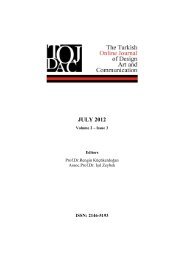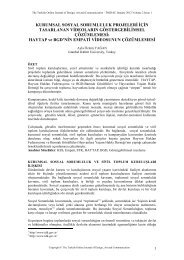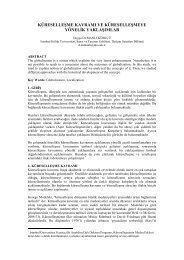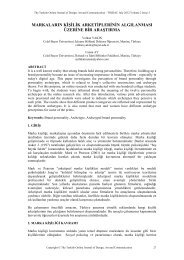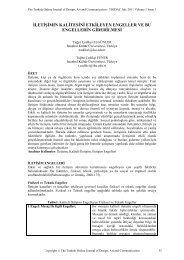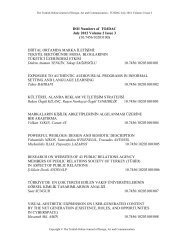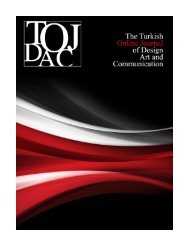aprıl 2012 - tojdac.org
aprıl 2012 - tojdac.org
aprıl 2012 - tojdac.org
You also want an ePaper? Increase the reach of your titles
YUMPU automatically turns print PDFs into web optimized ePapers that Google loves.
The Turkish Online Journal of Design, Art and Communication - TOJDAC April <strong>2012</strong> Volume 2 Issue 2<br />
they don’t belong to <strong>org</strong>anizations or political blocs, it is inevitable to show interest in diversity<br />
and interest groups to gain additional popularity among those groups. The study also showed that<br />
the political frame occurred as the second most common frame among the liberal group. As<br />
discusses in the literature, liberal group’s main objectives include respect for human rights, social<br />
justice and interest in political developments. Therefore, the political frame was especially<br />
evident in liberal group’s messages as it meets their objectives and their audiences'<br />
expectations.The study revealed that the symbolic frame was the second most commonly used<br />
frame by the Islamist group. The predominance of the symbolic frame in the Islamists group’s<br />
can be explained by the Islamist group’s aspiration and purpose. The symbolic frame entails that<br />
members use symbols and culture to provide a shared sense of mission and identity (Comwings et<br />
al., 1996). The questions to answer this variable were mainly about the use of religious quotes,<br />
culture, and human values and traditions. Therefore, as explained in the literature, Islamist<br />
members are concerned with social and cultural issues and this frame is based on things<br />
embedded in the culture such as Sharia law, religious values, or quotes from the Qura’an.<br />
Although the most common used frame by the populist party was the structural frame, the human<br />
resource frame ranked second. The populist party encourages labour unions and <strong>org</strong>anizations and<br />
represents unions’ needs in the assembly, therefore the human resource frame resembles these<br />
objectives as the frame includes being responsive to people's needs as well as people’s<br />
empowerment.<br />
In addition, the human resource frame was ranked third among the liberal group framing. As the<br />
human resource frame focuses on human needs and value feelings and relationships through<br />
facilitation and empowerment (Mosser &Walls, 2002).The aptness for liberal members to<br />
empower their followers and encourage political participation is inevitable as they believe in<br />
building a civil society and achieve democracy. The final aim of this study was to investigate<br />
whether the prevalence of frames in MPs messages varied by topic. There has been a trend in the<br />
use of the four leadership frames-human resource, politics, structural, and the symbolic-as they<br />
were associated with the general topic of the message. In general, political issues were especially<br />
evident in the structural frame messages. This may be due to the finding that the structural frame<br />
is concerned with issues of leaders’ strategies, goals and objectives. MPs strategies and goals are<br />
usually intersected with political issues such as laws, policies, corruption, the constitution and<br />
new regulations. The social frame was mostly associated with the symbolic frame which may be<br />
explained by the nature of the frame that focuses on traditions and human values. Moreover,<br />
religious issues were mostly found in the symbolic frame and that makes sense as the frame<br />
focuses on religious quotes, values and traditions which are usually issues related to religion.To<br />
conclude, parliament members in Kuwait utilize social media to interact, build their social capital<br />
and gain public acceptance using various leadership frames such as symbolic, structural, political,<br />
and human resource frame. Yet, the most dominant frame used by Kuwaiti parliament members<br />
in Twitter was the structural frame that suggests that leaders set direction, strategy, causes and<br />
effect, and hold people accountable. The way parliament members frame their messages in<br />
Twitter and the differences in leadership framing among political groups that this study prevailed<br />
can have important implications for public understanding and evaluation of political actors,<br />
political parties, and social media literacy. For further research, it is important to identify further<br />
characteristics that may be qualified for testing each frame on a political context as Bolman &<br />
Deal’s leadership frames focuses on <strong>org</strong>anizational leaders.<br />
REFERENCES<br />
Copyright © The Turkish Online Journal of Design, Art and Communication<br />
132



